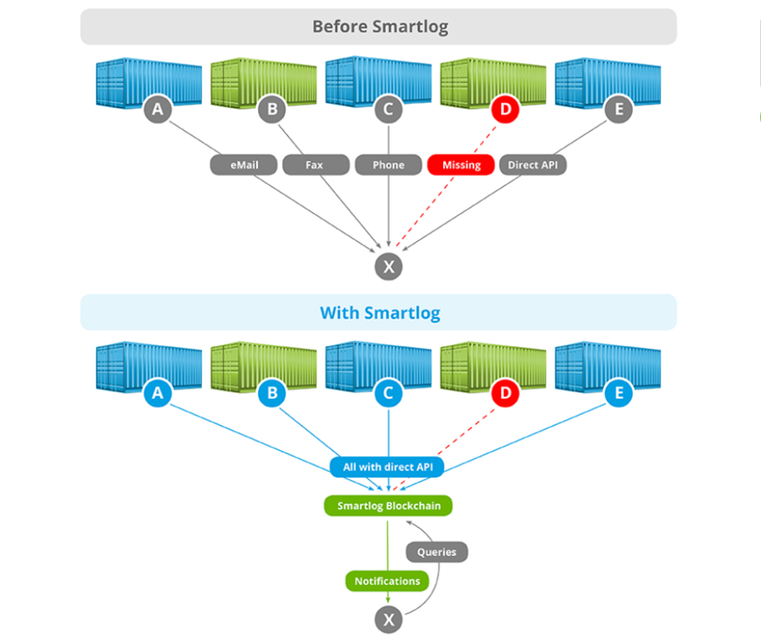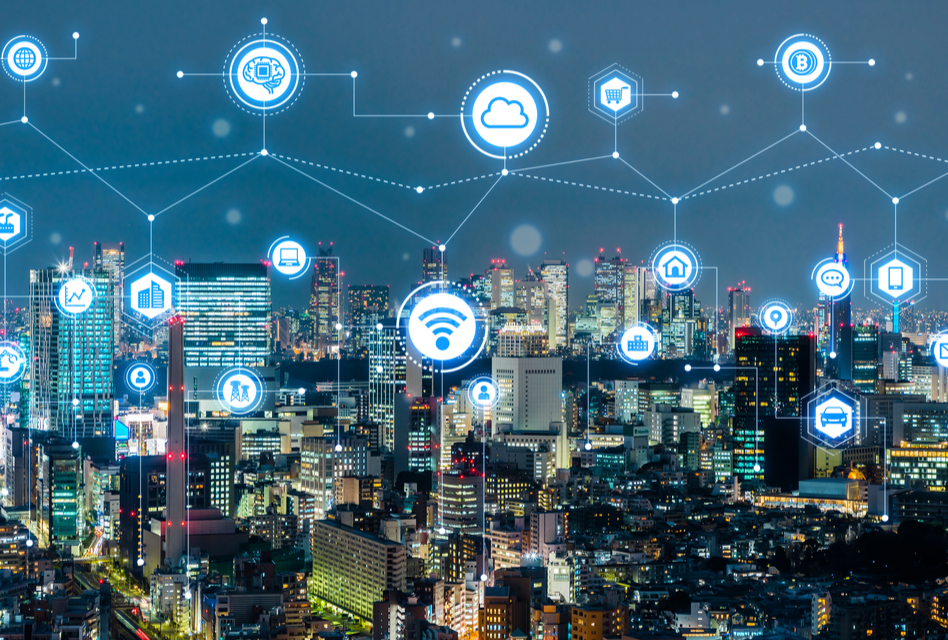When paired, blockchain and the Internet of Things (IoT) have the ability to revolutionize industries and the way we live. Each day seems to bring a new blockchain IoT use case, whether it be for the health, financial, automotive, or food industries. It is believed that in 2019 20% of all IoT devices will be built on blockchain. The following are just a few of the blockchain and IoT use cases being developed today.
Article Contents
Smarter Radiation Dosimetry with IoT Blockchain
Organizations involved: Clinitraq, NetObjex
Project status: The product appears to be completed, and the demo can be requested on Clinitraq’s website.
Sources: NetObjex’s case study
Clinitraq is a healthcare company that is currently building a dosimeter utilizing NetObjex IoT-Blockchain Platform. Dosimeters are badges that measure radiation levels its wearer has been exposed to. Current dosimeters can take between 30 to 60 days to provide results, whereas Clintraq’s dosimeter can provide results in real time. This is extremely beneficial to people who work in health or science as it helps to eliminate the risk of being exposed to too much radiation. As it is linked to NetObjex’s IoT-Blockchain Platform, data can be tracked, and firmware updates can be administered through the cloud.
Bringing Biometrics to Blockchain
Organizations involved: Telstra
Project status: Telstra introduced its IoT network in 2017. Since then, the company has been working to release a wide variety of products utilizing IoT.
Sources: Article concerning Telstra’s IoT network
Australian telecom company Telstra is using blockchain paired with IoT to make its smart home system safer. As most smart homes currently rely on mobile apps for control, a device infected with malware can lead to nefarious actors gaining control. By uploading biometrics, such as face or fingerprint recognition, into a blockchain, Telstra provides a safer and more secure network.
Improving Efficiency with Automated Planning
Organizations involved: TimeSeries, Van Dorp
Project status: Automated Planning is the service TimeSeries provided for Van Dorp. It is just one of the many services TimeSeries provides utilizing blockchain, IoT, and AI.
Sources: TimeSeries Automated Planning use case
Van Dorp is a facilities management (FC) company that manages around 17,000 buildings across the Netherlands. The company is in charge of maintaining air conditioning, lighting, and heating systems. With only 600 Van Dorp mechanics at hand, managing these systems can be an enormous task.
TimeSeries uses blockchain, Mendix, artificial intelligence (AI), and IoT technology to provide management solutions to businesses. The company developed a management platform for Van Dorp, which allows them to categorize mechanics by services, location and historical data, improving Van Dorp’s maintenance planning.
Building owners utilizing IoT are now able to track how various systems are running throughout their building and be notified when a Van Dorp mechanic is on the way. By utilizing TimeSeries’ automated planning solutions, Van Dorp has been able to increase their planning efficiency by over 30%.
Streamlining Efficiency in Logistics with IoT Blockchain

Organizations involved: Kouvola Innovation Oy, Tallinn University of Technology, Valga County Development Agency, Sensei OU, Orebro Region, Latvia Transport and Telecommunications Institute
Project status: The project is ongoing, but its results are expected to be released sometime in 2019.
Sources: Smartlog project site
With a runtime of three years, from 2016 till the summer of 2019, SmartLog is in the process of researching and developing a proof of concept project that aims to cut cargo unit transportation times.
An industry-wide problem in cargo shipping is a lack of communication which affects shipping times. Blockchain, with its ability to provide shared information in real time, is a simple solution to this problem. The idea is to store shipment transactions on the SmartLog blockchain, track them using IoT, and automate tasks using smart contracts, thereby bringing better organization and communication to the industry.
Six organizations from four different countries are currently working on the project. This is one of many blockchain IoT examples in which multiple organizations are teaming up to expand the technology.
Bumble Bee Foods Betting on IoT Blockchain
Organizations involved: Bumble Bee Foods
Project status: Costa discussed his views of blockchain and IoT technologies at an SAP event held in September 2018. SAP is a German software company currently working on blockchain and IoT-based solutions. Given the increased interest in these two new technologies, it would not be unlikely to see Bumble Bee Foods start to develop some form of a blockchain-and-IoT platform in 2019.
Sources: Tony Costa SAP interview, article with Costa’s blockchain views
Tony Costa, Senior Vice President and Chief Information Officer of Bumble Bee Foods, envisions a bright future for IoT and blockchain. The company is currently exploring the use of blockchain for the provenance of its tuna products.
Currently, the company tracks tuna from when and where it is caught up until it is packaged. Costa eventually hopes to tag boats and fish in order to track them using IoT. Costa even hopes to build an app using IoT and blockchain, that will increase communication between fishing crews in order to triangulate the locations of large schools of fish.
Using Blockchain and IoT to Sustain the Palm Oil Industry
Organizations involved: Apical
Project status: After Apical described their interest in blockchain and IoT at an SAP event last year, the company has gone on to form SUSTAIN. Only a few months old, the alliance is continuing to seek new members.
Sources: Apical SUSTAIN press release, Singh SAP interview, Hyperledger use case
Apical, one of the largest palm oil exporters in Indonesia, hopes blockchain and IoT can ease the process of data acquisition in relation to tree and plantation productivity in the palm oil industry. Apical’s Head of Digital and IT, Abhishek Singh, described Apical’s current data challenges at an SAP event saying,
“The challenge for us is to move the data from pen and paper to a real-time data acquisition process.”
A Digitalist article shows that technology-based strategies are being sought after to increase productivity and promote sustainability in the palm oil industry. Tags using IoT technology can be placed in soil, water, and on trees to track the quality and productivity of plantations producing palm oil.
In September 2018, Apical teamed with various members of the palm oil industry to form the Sustainability Assurance and Innovation Alliance, or SUSTAIN, intended to improve sustainability in the palm oil industry with the use of blockchain.
Blockchain and IoT to provide Smart Parking Tools
Organizations involved: NetObjex, Advantech, PNI Sensor Corp.
Project status: NetObjex gave a demonstration in December 2017 of how the service could function. All the three companies currently offer services which in theory could provide for a smart parking structure.
Sources: NetObjex press release, Advantech parking service system, PNI PlacePod
At the IoT Developers Workshop in Santa Clara, California, NetObjex, Advantech, and PNI Sensor Corp. displayed how the frustration can be taken out of parking with IoT and blockchain. Each company offers services that when merged, function as a parking service you might see in a sci-fi film.
By utilizing NetObjex blockchain services, vehicles can be equipped with crypto wallets to automate parking transactions. PNI Sensor Corp.’s PlacePod is an IoT-enabled smart sensor that can be placed in parking spots to determine whether it is available or taken. Advantech’s Parking Service System provides the hardware and cloud service necessary for the program to function. Merged together, these three services automate transactions, display to drivers where available spaces are, and instruct them on how to get there.
Blockchain and IoT to End Water Waste
Organizations involved: NetObjex, Aquai
Project status: The project has been completed, but NetObjex has a variety of other projects and services currently in place.
Sources: NetObjex case study
Leaking water fixtures can add up to an astounding one trillion gallons of wasted water per year in the US alone. Aquai has developed Puck, a smart water sensor that tracks how much water you use and automates the shut-off of water if a leak is detected. It uses NetObjex’s IoT and blockchain services to monitor and store data. Aquai also plans to introduce other services related to water damage caused by leaks.
Using Blockchain and IoT to Measure River Contamination
Organizations involved: Libelium, Airalab
Project status: The joint project has been successfully completed. Libelium offers smart water sensors using IoT on its website.
Sources: Libelium press release
Monitoring water quality can be an expensive and time-consuming process, so Libelium and Airalab have teamed up to provide a cheaper solution. “Drone on the Volga” is a project completed by the two companies, using a drone equipped with IoT and blockchain technologies to autonomously collect water contamination levels.
The drone takes water readings of the Kuybyshev Reservoir in the Volga river and uploads the data to the Ethereum blockchain in real time. By utilizing IoT, the drone can identify where and when readings were taken, assisting scientists in the process of discovering where contamination is coming from. The project uses Libelium’s water sensors paired with Robonomics Platform developed by Airalab.
You may also like:
Blockchain In the Supply Chain: 10 Real-Life Use Cases and Examples
A glimpse at blockchain applications in supply chain.





Blockchain Insights
Join our mailing list to receive OpenLedger Insights publications weekly.
Thanks! Please check your inbox to verify your email address.
By clicking “Subscribe”, you’re accepting to receive newsletter emails from OpenLedger Insights every week. You can easily update your email or unsubscribe from our mailing list at any time. You can find more details in our Privacy Policy.